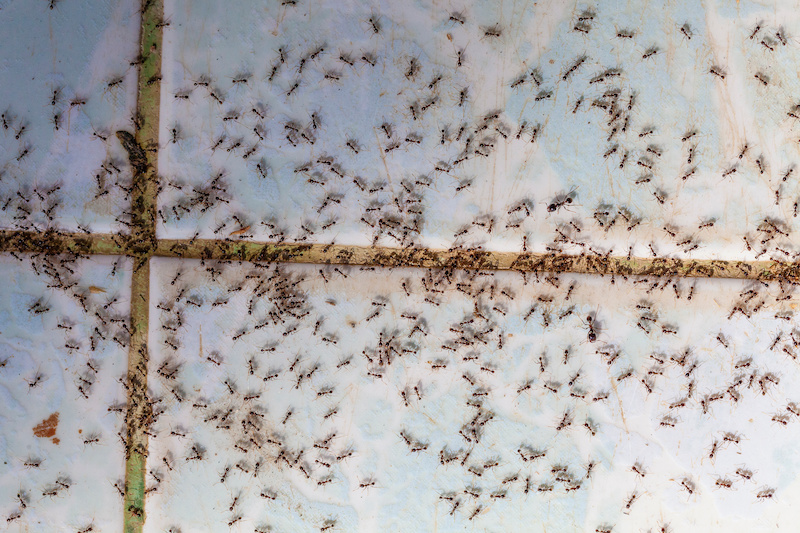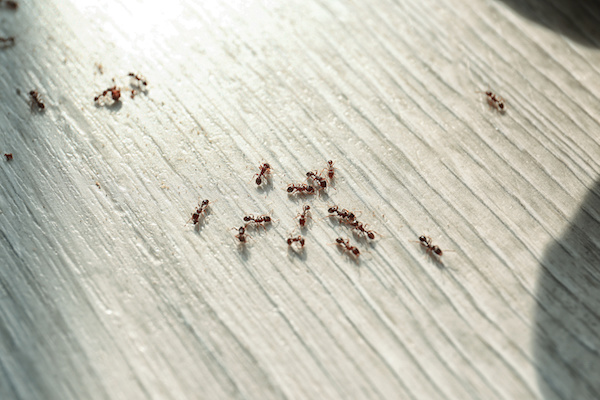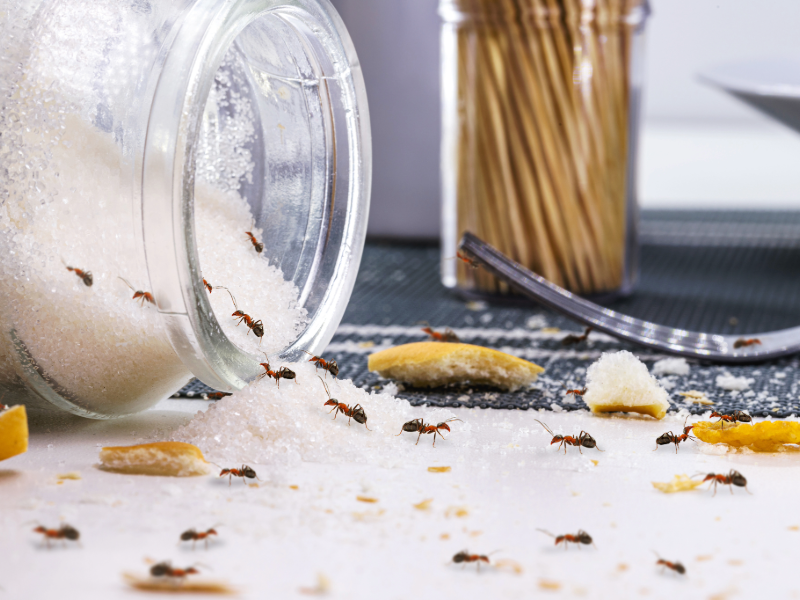Your home should be for houseguests, not invading pests! Discovering ants sneaking around your space can be frustrating, particularly when the cause is unclear. Whether it’s due to kitchen spills or growing indoor colonies, there are multiple reasons why you may have acquired some unwelcome roommates.
Continue reading to delve deeper into why ants might invade your Oregon or Washington home. Armed with our know-how and insights, you can easily eliminate current infestations and prevent future ones from cropping up.
Types of Ants You’ll See Indoors
Understanding the different species that may be making themselves at home in your space is key to getting rid of them for good. Let’s look at some of the usual suspects you might encounter, from tiny thieves to destructive woodworkers:
Odorous House Ants (Tapinoma sessile): These are the most common ants across Oregon and Washington. They have a sweet tooth, drawn to sugary treats and moist environments like kitchens and bathrooms. However, don’t try to step on one of these pests— as their name suggests, they’ll release a pungent odor whenever crushed.
Carpenter Ants (Camponotus spp.): These big ants aren’t just interested in your snacks; they’re after your wood, too! Unlike termites, carpenter ants won’t eat wood. Instead, they carve out cozy nests in damp or rotting wood. Keep an eye out in your basements and crawl spaces for leaks or deteriorating wooden materials. Beware, carpenter ants are also the only wood-destroying insects that will infest dry, sound wood!
Pavement Ants (Tetramorium caespitum): These ants prefer to set up camp under sidewalks and building foundations, hence their name. They’re not picky eaters, happily munching on everything from sugar to protein. As they dig out their galleries, however, they can eventually cause damage to driveways, sidewalks, and other pavement structures by removing a substantial amount of substrate. As the soil is removed for their galleries, the weight of the pavement causes the surface to sink, leading to cracks in the paved surface. These cracks invite more pavement ants, and the cycle continues!
Pharaoh Ants (Monomorium pharaonis): These small intruders thrive in warm, humid environments. They’re more than a common annoyance; these pests can carry and transmit disease as they roam and forage. Stay vigilant, especially in areas where they may flourish, like multifamily apartments, commercial buildings, and hospitals. This ant species is also known to be one of the most difficult to control.
Thief Ants (Solenopsis molesta): Small and stealthy, these yellowish-brown ants love raiding your pantry for greasy or oily foods. They’re experts at squeezing through tiny cracks and crevices to gain entry into your home.
Why Are There Ants in The House?
Curious about the ants roaming your home? Here’s why you may see these little critters indoors.

You Have Cracks In Your Walls
Ants can effortlessly infiltrate your home through small cracks and gaps, no matter the source. Here are a few areas ants may utilize to sneak inside:
- Foundation and wall cracks
- Gaps between doors and surrounding walls
- Transitions between walls and windows
- Small holes near pipes, vents, or electrical lines
- Water lines accessed by exterior hose spigots
While these spaces seem insignificant, they provide convenient access for foraging ants. Plus, as the cracks widen over time, ants and other pests will have an easier time gaining entry indoors.
We recommend sealing these gaps and cracks to prevent ants from spreading throughout your home. While challenging and time-consuming, these proactive measures can mitigate severe pest infestations.
They Crawl Through Open Windows
Spring and summer weather may tempt us to throw open our windows for a breath of fresh air. However, the windows may welcome more than just the breeze. Even with the window closed, ants can still enter through tiny gaps in the caulking or the weep vent, that little hole on the outer window frame that allows moisture to escape the window pane.
Wooden window frames, in particular, are susceptible to moisture, making them prone to rot—a perfect invitation for carpenter ants searching for a new home. To prevent ants from exploiting these entry points, inspect the screens, window panes, and wood annually to ensure everything is in working order.
And if you start to notice critters crawling through your windows, give us a call!
They’re Looking for Food
Ants have a keen eye– and nose– for finding food. And they’re not picky either. Once a foraging ant finds a hearty food source inside your home, it’s not long before you have a trail of wandering ants in your house.
Pet food, garbage cans, and improperly sealed food containers are all irresistible temptations for these tiny scavengers. Sweet treats like sugar, honey, and syrup also hold a particular allure for many ant species, meaning your fruit and pantry sugar aren’t safe from their clutches.
But it’s not just what’s visible that ants go after; they’re also adept at detecting hidden food residues and crumbs tucked away in hard-to-reach spots, like beneath appliances or inside cabinets and drawers.
To minimize the risk of ant infestations driven by food sources, regularly clean your home and practice proper food storage practices. For current infestations, we’ve got you covered.
They’re Seeking Shelter
You may have ants in your house if the weather outside is poor. These pests may seek shelter indoors if they lack favorable conditions outdoors. Here are a few reasons why they may venture into your home:
- Protection from the Elements: When the weather turns extreme, like during heavy rain or scorching heat waves, ants could seek shelter in our homes to escape the harsh outdoor conditions.
- Craving Moisture: Some ant species are drawn to moisture-rich environments. Leaky pipes or damp spots inside the house can provide the perfect hydration station for ants.
- Perfect Nesting Spots: From cozy wall voids to snug insulation, our homes offer plenty of hiding spots for ant colonies to call home sweet home.
- Access to Food: Once inside, ants quickly scout out potential food sources. They’re likely to stick around if they find plenty to munch on.
No matter the reason, your home shouldn’t be home to pests. Whenever you see the first signs of an infestation, contact a trusted pest professional for an inspection and treatment.
Scent Trails Bring Them Indoors
Once ants find a promising food source, they will leave behind a trail of pheromones as they return to the colony. These pheromones act as a chemical breadcrumb trail, guiding other ants from the nest to the food source.

As more ants travel along the scent trail, they deposit additional pheromones, further strengthening the trail and making it more enticing for others to follow. This reinforcement continues until the food source is depleted or the trail is disrupted.
Ants are adaptable creatures and can quickly adjust their behavior in response to environmental changes. If a scent trail is disrupted or the food source is removed, ants will actively search for alternative routes or new food sources to replenish their colony’s supplies, meaning you’ll often need professional help to eliminate the ants in your house.
They’re Establishing New Colonies or Satellite Nests
While most ants prefer to stick to their outdoor colonies, some ant species, like carpenter ants, feel right at home within your space.
Carpenter ants are attracted to damp or decaying wood. They often seek out areas where wood has been softened by moisture, such as window frames, door frames, or roof eaves, to establish new colonies.
Unlike termites, which consume wood for nutrition, carpenter ants excavate galleries to create nesting space, discarding the wood debris outside the nest. As the colony grows, the ants expand their nesting area and forage for food to support the colony’s needs.
If left unchecked, carpenter ants can cause significant structural damage to homes over time. Their nesting habits gradually weaken wooden structures, risking structural integrity and often necessitating expensive repairs.
Similarly, odorous house ants, like many ant species, have multiple queens per colony. When these colonies expand, they send queens out to establish new nesting areas. Disturbing these ants with over-the-counter pesticides, household cleaners, or homemade oil concoctions can cause this species to “bud” or expand their colonies to safer areas.
They’re Following Other Pests
You can also have ants in your house because of two main attractions: the presence of aphids on indoor plants and the sweet nectar these plants produce.
Aphids secrete honeydew as they feed on plant sap, which ants find irresistible. They often protect aphids from predators and help them move to new plants to ensure a steady supply of honeydew.
Additionally, ants are drawn to the sweet nectar of indoor plants, foraging on flowers and leaving scent trails to guide other ants to these food sources. If you accidentally bring in plants infested with ants, they can return to the colony and bring back more pests to forage.
Natura is Your Go-To For Ant Pest Control!
Dealing with ants in your house demands prompt action to prevent the problem from worsening. While DIY methods may offer temporary relief, calling a professional pest control company is the most reliable solution.

Our services extend beyond just ants— we safely and efficiently eradicate all unwanted pests from your property. Contact us today to schedule an appointment!



